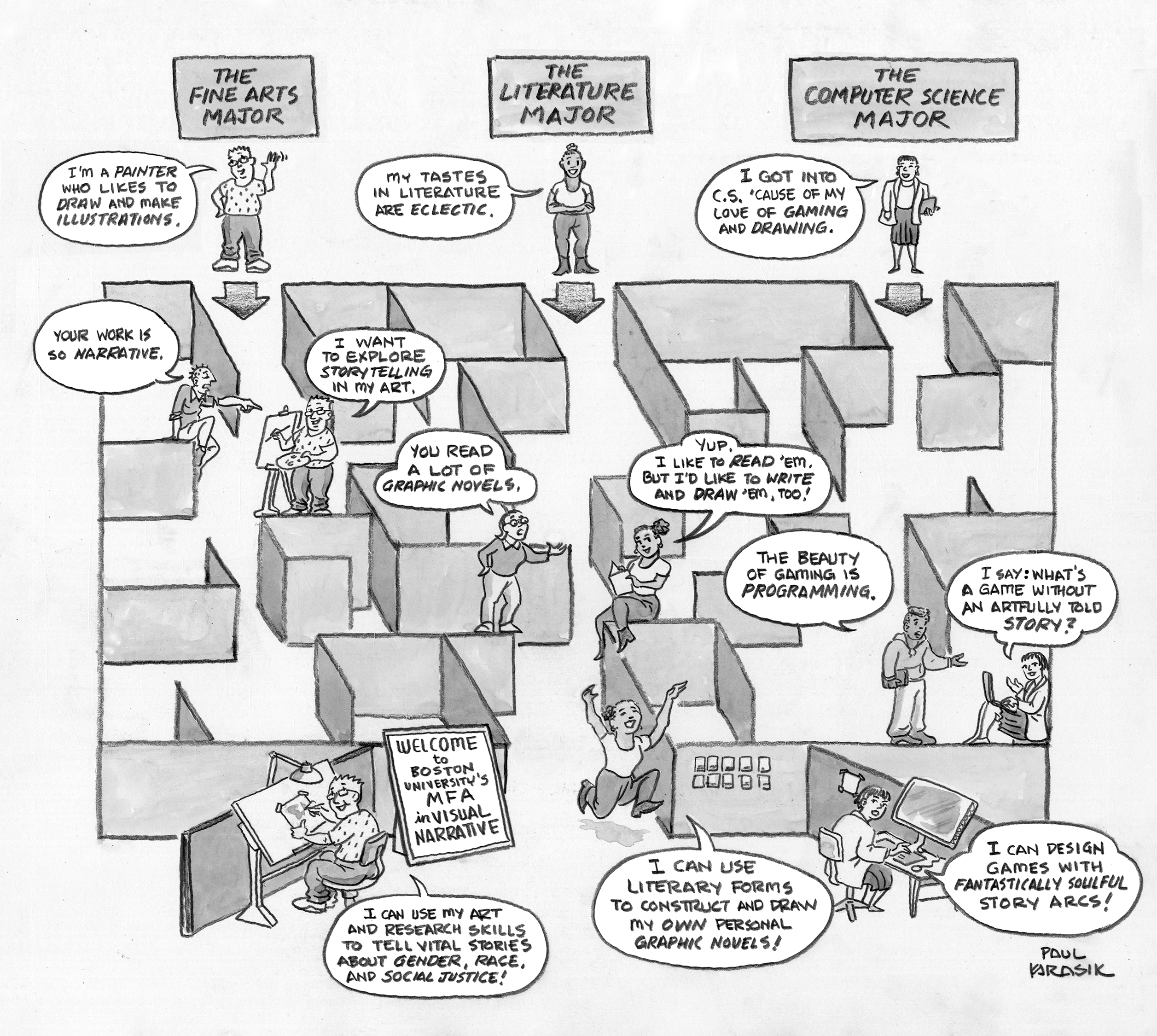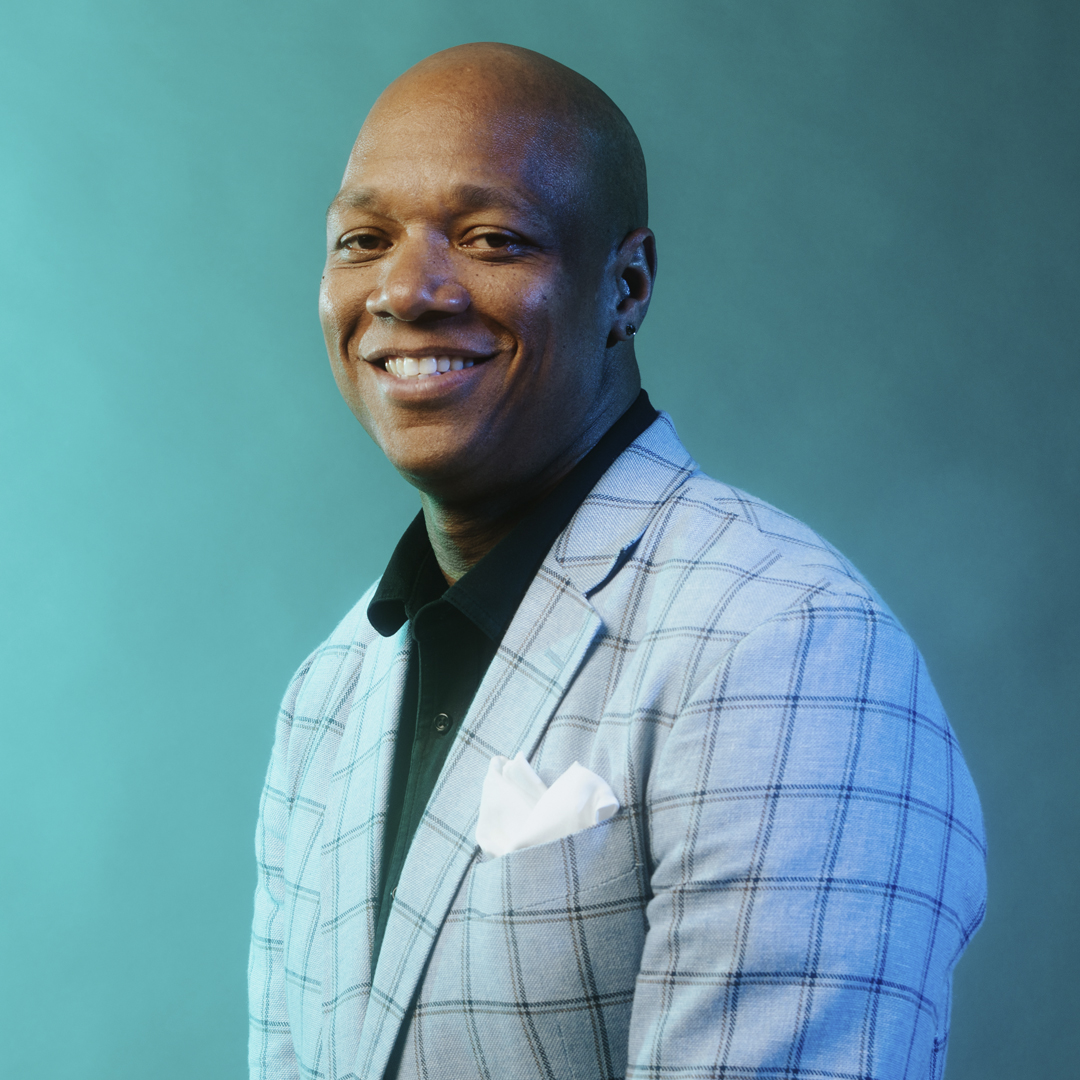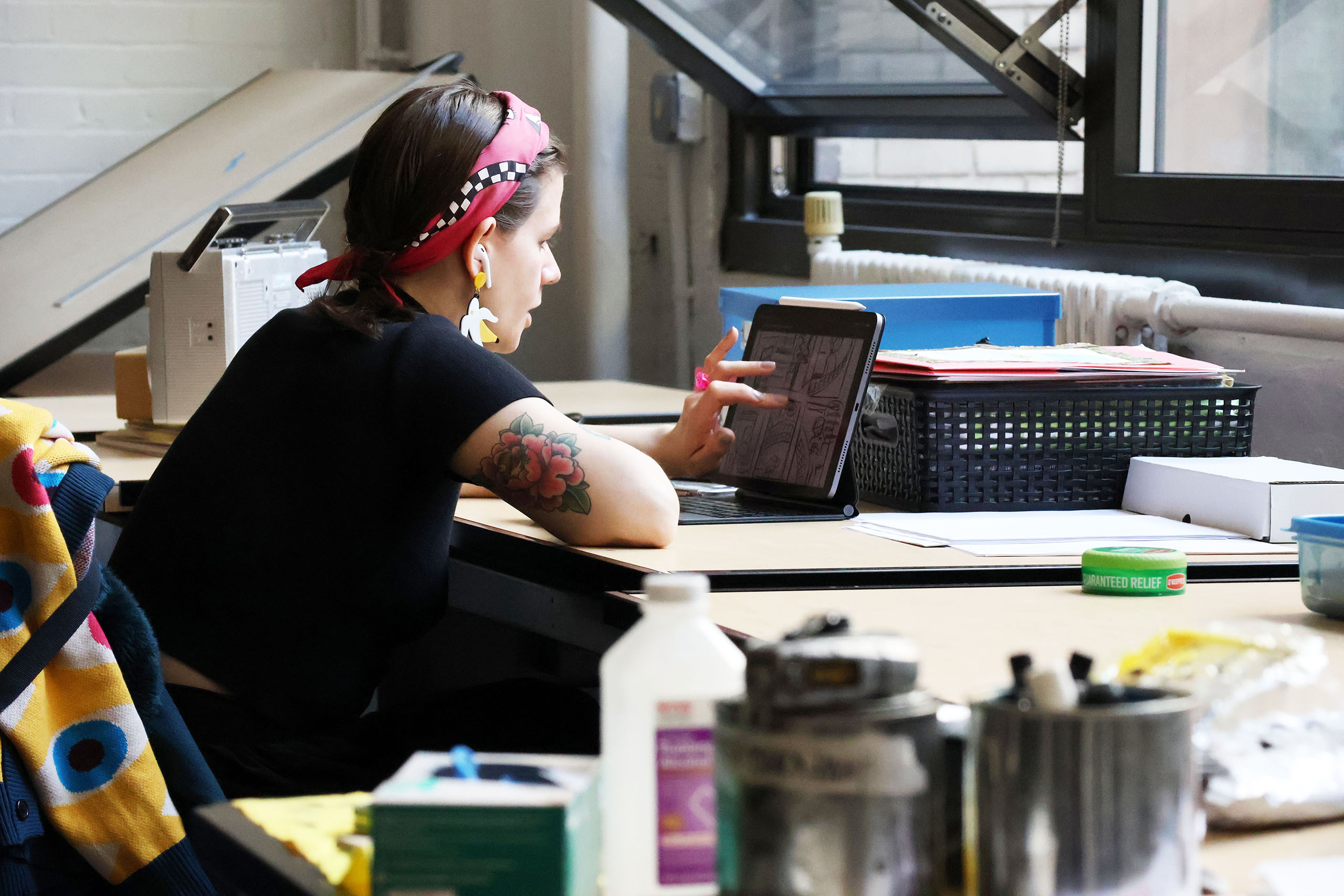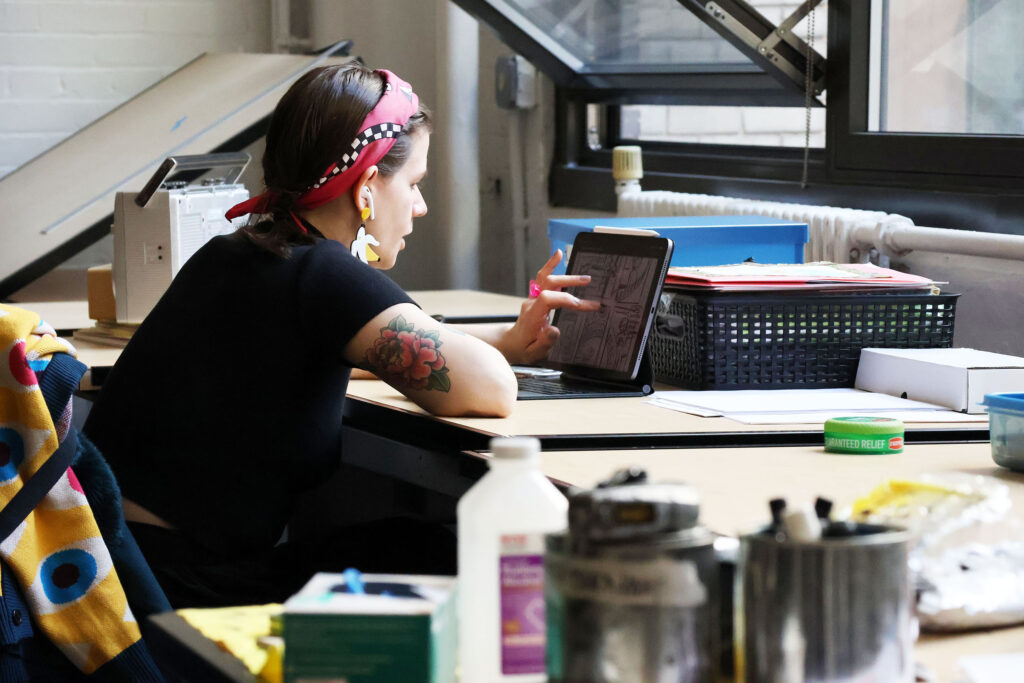Master of Fine Arts in Visual Narrative
Explore Recent Work of our MFA Community and Learn More About Visual Narrative
Be Part of it at BU. What stories will you tell?
An inside look at the MFA in Visual Narrative with Joel Christian Gill, Chair
Stories that make a difference.
Imagine yourself in the ideal studio for creating compelling visual stories and powerful narratives. The writer’s room atmosphere of the MFA program in Visual Narrative at Boston University School of Visual Arts (BU SVA) will provide you with a community of peers, faculty mentors, industry reviewers, and visiting artists to help you launch professionally. BU’s MFA in Visual Narrative is one of only a few graduate programs in the United States that teaches students to create professional-level comics, graphic novels, and picture books as they gain transferable skills in drawing, illustration, animation, visual storytelling, and publishing practices. Award winning critically acclaimed cartoonist faculty mentors work 1:1 at the table and tablet with students teaching how to craft stories in a range of media. You will learn how to pitch your work in word and image to related industries and expand your digital skills and exposure to a range of techniques through work in our well-equipped new studio and in electives across the College of Fine Arts and BU. Take part in major professional events hosted by BU for the larger community, along with exhibitions and collaborations that help you share your work with the professional world. Make your mark by doing what you love. Graduates are prepared to enter – and become leaders in – this quickly expanding field.

Credit: Paul Karaskik
The Master of Fine Arts in Visual Narrative helps you imagine new pathways
Core studio practice coursework with leading practitioner faculty is supplemented by electives and co-curricular learning in your chosen research areas. Opportunities for experiential learning include internships and collaborations with other courses and areas of study at BU. These strategic partnerships help students access related experiences: whether in theater, design, communications, science, social justice, or health, tap into the best of what BU has to offer to inform the depth of your stories. Upon completion of the degree, you’ll have the skills to tell the stories you want in the way you want to tell them.
You’ll be able to:
- Understand the power of narrative when written and visual media overlap and work in tandem.
- Communicate complex information that resonates with the intended audience emotionally and conceptually through both word and image.
- Conduct background research and write in humanities-based themes and contexts that inform and support individual graphic interpretation.
- Understand digital media and its importance and potential for expanding and integrating the use of design, animation and drawing in the field.
- Create original graphic narratives as author and draftsperson that demonstrate development of a creative and critical voice informed by past precedent and contemporary practice.
Because visual narratives can offer an approachable first-person perspective on social issues, students in their first year develop nonfiction narratives that are targeted to their specific area of personal engagement and conceptual artistic interest. Students may cover a wide variety of topics informed by their learning, such as social justice, history, gender studies, healthcare, and psychology to name a few. The second year is devoted to a thesis project developed in conversation with lead faculty and visiting critics and shared publicly prior to graduation.

What can you do with an MFA in Visual Narrative?
Earning your MFA in Visual Narrative will prepare you for a wide-range of future opportunities. You’ll be prepared broadly as an artist—with skills to work as a story artist, graphic novelist, comic book artist-author, on storyboarding, picture book writing and illustration, or as a political or humor cartoonist along with other forms of visual journalism such as graphic reportage. The degree prepares students to work with aspects of the publishing field, and other cross-over skills include character designer, Illustrator, or animator. There is ample room for entrepreneurial work in an expanding field and a career in a wide range of industries including illustration, game design, digital visual storytelling, medical humanities, film and entertainment, and digital and print media.
Teaching Assistantships with BFA and BA courses in art help you prepare you for a teaching career in higher education at a time when universities are expanding the field of graphic storytelling in their curricula.
You’ll also have access to BU’s worldwide network of alumni and connections to professions to help you build your career.

Graduate Resources and Community for the MFA in Visual Narrative program
MFA Visual Narrative students have 24 hour access to a shared dedicated Visual Narrative work space, and, with coursework, access to nearby focused-use studios for printmaking and photography, including silkscreen. With training throughout the program in both digital and analog approaches, students learn to expand the boundaries and professionalism of how they create, disseminate, and document their work. Students in the program are supported by the following College of Fine Arts and SVA resources along with other BU labs and centers:
- Multiple digital studios, including one dedicated solely for the MFA Visual Narrative program equipped with Wacom Cintiqs, one in Printmaking and one in Photography.
- A three-color RISO printer with large array of color drums for limitless color potential.
- Access to courses in printmaking along with state-of-the-art print facilities that include lithography, etching, relief, digital printmaking, and silkscreen.
- Book Arts classes and facilities including type.
- Proximity to 100 graduate students across art education, painting, sculpture, graphic design, and print, media and photography.
- The BUild Lab IDG Capital Student Innovation Center is home to people, programs, and collaboration space that helps all BU students and recent alumni transform their ideas into something real and develop innovation skills, an entrepreneurial mindset, and a strong community along the way.
- The Boston University Center for Antiracist Research, whose mission it is to convene researchers and practitioners from various disciplines to figure out novel and practical ways to understand, explain, and solve seemingly intractable problems of racial inequity and injustice.
- Boston University Libraries, including the African American Library, the Krasker Film/Video Library, the Mugar Memorial Library, the Music Library, and the The Howard Gotlieb Archival Research Center, which is a repository for historical manuscripts from notable figures in journalism, literature, dance, music, theater, film, television, and political and religious movements. It also houses a significant collection of original works from the Golden Age of comics, spanning the mid-20th century and beyond.

Start telling stories. Get the catalogue.

Rankings
Boston University is an internationally respected university with a reputation for excellence and extensive research.
Top 100 national universities (U.S. News & World Report college rankings)
Top 20 most innovative schools (U.S. News & World Report college rankings)
Top 100 graduate universities (QS Quacquarelli Symonds rankings)
Ranked #17 in Top 50 Best Colleges in Big Cities (Newsweek)
Ranked #25 for Best Value for academic excellence and economic value (U.S. News & World Report college rankings)
The Center for Measuring University Performance places Boston University among the top 50 research universities in the nation

Accreditation
Boston University is regionally accredited by the New England Commission of Higher Education (NECHE).

NASAD ACCREDITED
Boston University holds accreditation by the National Association of Schools of Art and Design (NASAD), an organization of schools, conservatories, colleges, and universities with approximately 363 accredited institutional members.
Interested in a Graphic Design program instead?
Consider BU’s MFA in Graphic Design.
Join a Strong Graduate and Alumni Community
You’ll also have access to BU’s worldwide network of alumni and connections to professions to help you build your career.
The development of partnerships and professional communities within, between, and beyond BU programs is a strength and priority of the SVA graduate programs as a whole. Outreach and a vibrant intellectual and artistic ecosystem are brought into being through the following platforms for knowledge-sharing, and by important partners who help support graduate research, community, and new forms of production and thinking.
- Tuesday Night Lecture Series
- Contemporary Perspectives Lecture Series
- Boston University Art Galleries
- Piano Craft Gallery
- MFA field trips
- Open Studios
- Visual Arts Research & Resource Library
- Howard Gotlieb Archival Research Center and BU Libraries
- Multiple Formats Art Book Fair and symposium
- The Center for Antiracist Research
- The Howard Thurman Center for Common Ground
- Professional development programming hosted by School of Visual Arts
- BU Spark! (Center for Data Science)
- Engineering Product Innovation Center (EPIC)
- BUild Lab
- AIGA
- BU Medical Anatomy Lab
Faculty Spotlight

Joel Gill, Associate Professor of Art; Chair, Department of Visual Narrative
Joel Christian Gill is a cartoonist and historian who speaks nationally on the importance of sharing stories. He is the author of the acclaimed memoir Fights: One Boy’s Triumph Over Violence, cited as one of the best graphic novels of 2020 by The New York Times and for which he was awarded the 2021 Cartoonist Studio Prize. He wrote the words and drew the pictures for Fast Enough: Bessie Stringfield’s First Ride and the award-winning graphic novel series Strange Fruit: Uncelebrated Narratives from Black History, as well as 3 volumes of Tales of The Talented Tenth, which tell the stories of Bass Reeves, Bessie Stringfield and Robert Smalls.
Gill is the Chair of the MFA in Visual Narrative at Boston University. Catch all his updates on Instagram, Tik Tok @joelchristiangill and on Twitter @jcg007.

 APPLY NOW
APPLY NOW

